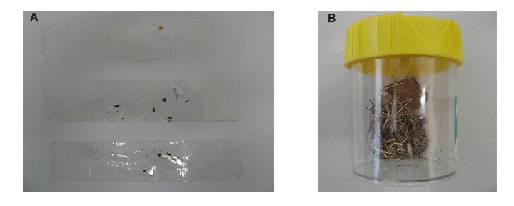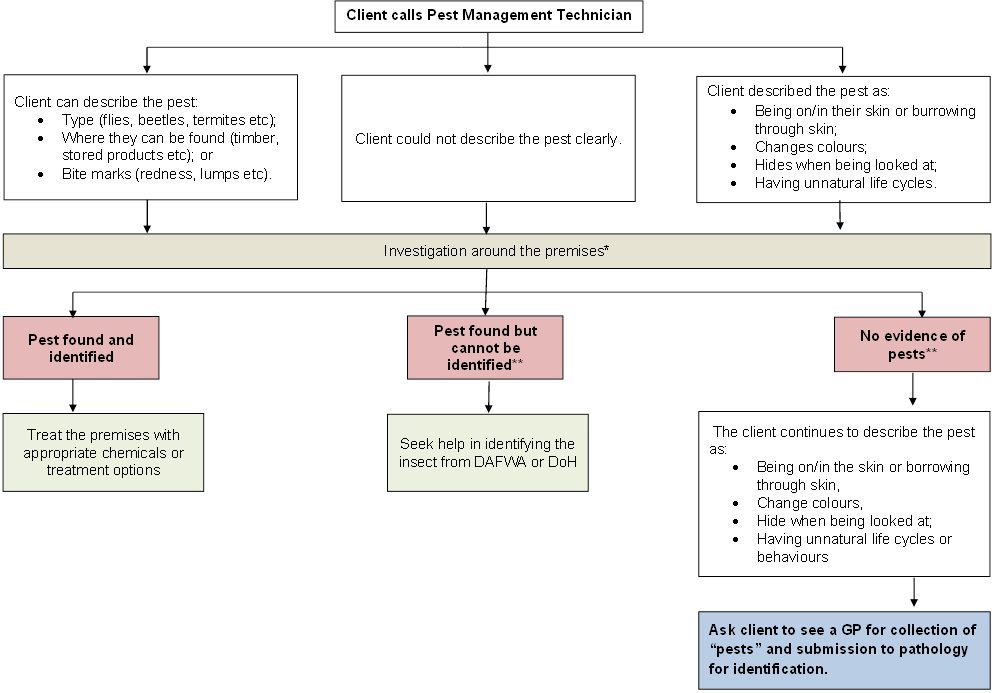What is Delusional Infestation?
Delusional Infestation (DI), previously known as delusional parasitosis is an uncommon mental health condition.
DI suffers hold a strong belief that they, close family members or their surrounding environment is infested with small creatures such as lice, mites, bed bugs or creatures “new to science”.
DI suffers also have itching, biting and crawling sensations in/on their skin, due to these imaginary creatures.
DI can occur in any age group. It is most common in older people aged 40 to 60 years and is twice as common in females.
How to recognize Delusional Infestation Clients?
Clients with DI often:
- frequently describe itching, crawling and biting sensations in/on their skin.
- provide very detailed descriptions of the pest, their ‘life cycle’ and behaviour.
- strongly reject the idea that the “bugs” do not exist or are imaginary.
- spend hours every day cleaning, scrubbing, and sterilizing clothes, skin, furniture and even vehicles.
- treat skin and clothes with pesticides, gasoline, kerosene, chlorine, toxic chemicals and various home remedies.
- have sores or scratch marks from trying to remove creatures from the skin.
- provide pieces of skin, dust or other material for identification of pests.
How do you approach clients with Delusional Infestation?
The most important thing is to investigate the “pests” as described by the client. If a client describes the “pest” as:
- being on/in their skin or borrowing through the skin.
- changing colours.
- hiding when being looked for or
- having unnatural ‘life cycles’ or behaviours that do not fit common pest species.
then the client could be suffering from DI. Pest Management Technicians should not be examining client’s bodies and should refer them to their doctor.

Typical specimens collected by Delusional Infestation Clients
A: Skin scrapings from patient’s skin containing dust and lint often collected onto sticky tape.
B: Urine collection container containing dust and plant matter often collected from window sills.
During pest inspections:
DO:
- inspect the premises thoroughly to find any pest insects around the home.
- treat the premises as usual if pests are found and only if treatment is required.
- seek advice and support from your supervisors when dealing with possible DI individuals.
- limit your inspection to the premises and surrounds.
- ask the patient to see a doctor if they indicate insects crawling on/in the skin.
DO NOT:
- treat the premises if there is no evidence of insect/pest activity.
- PMTs must not conduct any chemical treatments if pest species cannot be found as it may encourage the DI Patients belief that they are infested with insects/creatures.
- Continual exposure to certain pesticides such as Synthetic Pyrethroids may result in some individuals suffering skin sensitivity known as “paraesthesia.” “Paraesthesia can cause numbness, tingling, or a "pins and needles" feeling on the skin.
- Under the Health (Pesticides) Regulations 2011 it is an offence to use a pesticide which “may pose a danger or threat to the health and safety to any individual or the public.”
- Excessive use of pesticides may also result in resistance to the chemical in the insect population.
- Do not look at the person’s body or specimens such as skin scraping, dust, clothes and so on.
- Do not argue with clients, DI clients are very persistent with their opinion; it is unhelpful to argue with them.
- Do not encourage or agree with the client’s opinion, as this will confirm their beliefs of insect infestation.
It is essential not to attempt to convince clients that the disorder is a mental health matter. Only a medical professional should treat a client.
Principal causes of itches and bites of unknown origin
It is important to recognize that there are many potential causes of itching and irritation of the skin other than that caused by insects. Allergies, cosmetics, medications, and environmental conditions or contaminants may also produce reactions comparable to insect bites to some people and some animals alike.
Common causes of itchiness and rashes include:
Biting arthropods:
- mites (e.g., bird, rodent, scabies)
- lice
- fleas
- biting midges or mosquitoes
- ticks
- bedbugs
Household Products:
- detergents (especially phosphate-based)
- soaps
- cosmetics/hair products
- ammonia-based cleansers
- medications
- printing inks
- clothing (static prone)
Environmental Factors:
- Physical irritants
- paper, fabric, or insulation fibres
- low humidity (refrigerated air conditioning)
- seasonal changes in temperature
- static electricity
- Chemical irritants
- formaldehyde (e.g., from particle board, wall and floor coverings)
- ammonia
- Solvents/resins associated with paints and adhesives
- volatiles from asphalt and tar installation.
Identification Services:
Improve your knowledge, if you don’t know what the insect is, get help with identification from:
Department of Health, Western Australia: Medical Entomology team. Provides identification services of invertebrates for pathology centers, Doctors and Pest Technicians. (08) 9285 5500 or email medical.entomology@health.wa.gov.au
Department of Agriculture and Food, Western Australia: provides invertebrate identification for biosecurity surveillance. Unfamiliar insects or insects which may have originated from interstate or overseas should be submitted for ID – contact Pest and Disease Information Service (external site): 1800 084 881 or use the MyPestGuide Reporter app for identification services.
In Summary:

*If no insect is found and the client has openly discussed itching, burrowing sensations in/on their skin, the pest controller should encourage the client to visit a doctor for diagnosis.
**If no pests are found, the Pest Management Technician should not apply any treatment. Under the Health (Pesticides) Regulations 2011 it is an offence to use a pesticide which “may pose a danger or threat to the health and safety to any individual or the public.”
For more information:
Medical Entomology
Environmental Health Directorate
Department of Health
PO Box 8172, Perth Business Centre, Western Australia 6849
Telephone: (08) 9285 5500
Email: medical.entomology@health.wa.gov.au